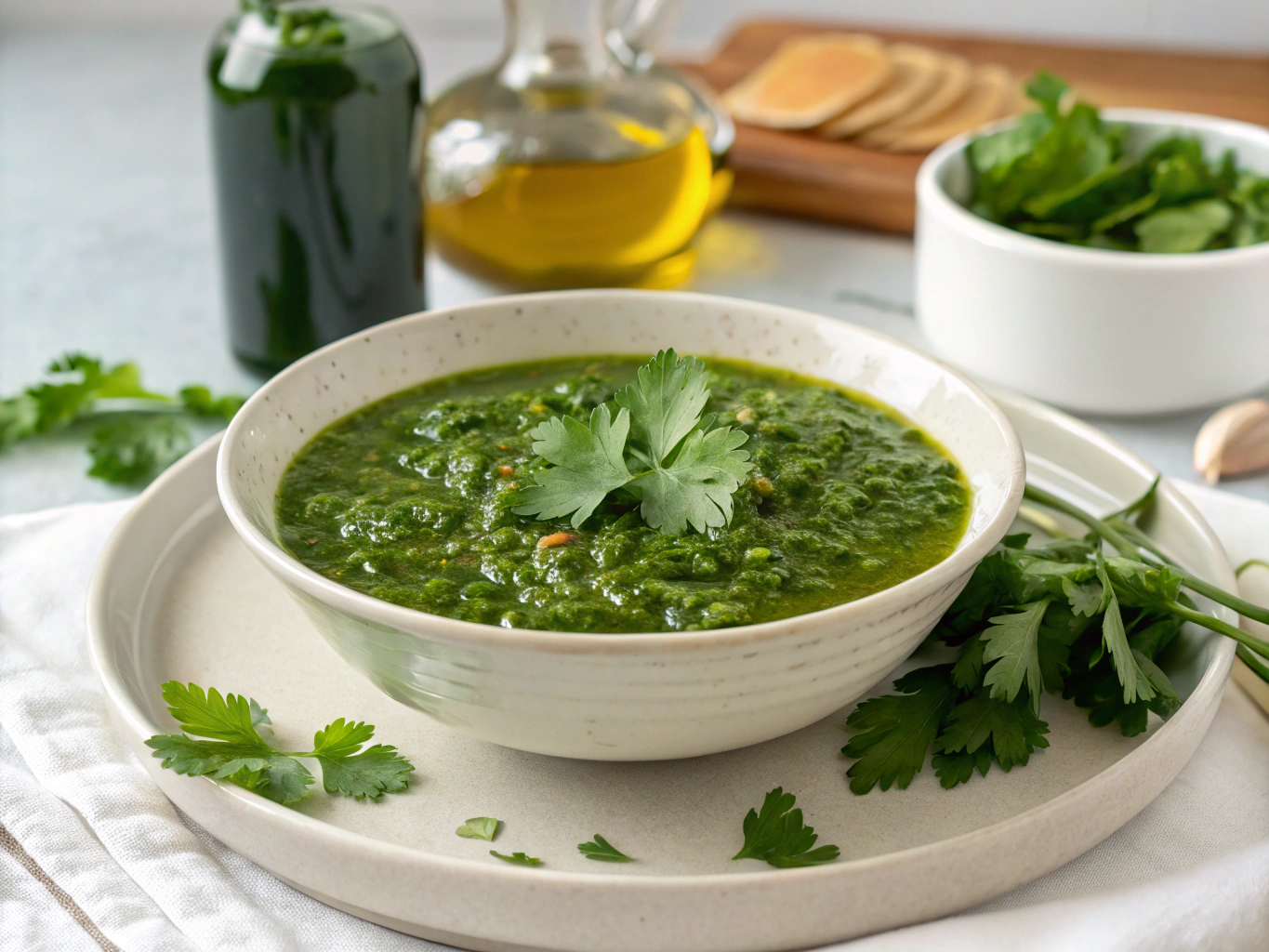
Chimichurri sauce isn’t just a condiment—it’s a flavor-packed experience that transforms humble ingredients into bold personality on a plate. In this article, we’ll dive into my personal journey with this iconic Argentinian sauce, explore its origins, walk through a no-fail homemade recipe, and serve up creative uses beyond grilled meats. Whether you’re new to chimichurri or trying to master your own signature version, you’ll walk away ready to stir, taste, and drizzle with confidence.
Let’s begin with the story that brings this vibrant green sauce to life.
A Charleston Soul Meets Chimichurri
A Southern Introduction to Argentinian Boldness
The first time chimichurri sauce hit my tongue, I was at a friend’s summer potluck, tucked under the oaks here in Charleston. It wasn’t love at first bite—it was revelation. Tangy, peppery, herby… it punched past everything else on that smoky grilled steak. I asked them what it was, and they just said, “It’s chimichurri. You gotta make it.” So I did—for weeks on end.
Raised in a kitchen where everything was by instinct and touch, where my grandmother’s cast iron pan was gospel, I wasn’t intimidated by the free-form style of chimichurri sauce. It’s one of those recipes that actually begs you to make it your own, which aligns perfectly with how I cook—comfortable with the classics, always ready to twist.
Now, chimichurri sauce shows up on everything from my roasted vegetables to scrambled eggs. At FlavivoRecipes, it’s one of those go-to sauces I always recommend when folks ask how to “jazz up” a dish without cluttering up their pantry.
For example, you can even pair this punchy green goodness with dishes like easy crispy tofu bites, where it balances the richness with acidity, or even with garlic herb mashed potatoes, adding a bright counter to a buttery classic.
Chimichurri is a kitchen whisper that quickly becomes a kitchen shout—and once you make it, you’ll get that little thrill every time you hear it sizzle on something hot.
Why This Sauce Deserves a Spot in Your Weekly Repertoire
Chimichurri sauce covers so many flavor bases—it’s herbaceous, tangy, garlicky, and just a little spicy. And you don’t need anything fancy. There’s no blender required. Just a cutting board, sharp knife, and maybe a jar. What makes this recipe shine is balance. Whether you serve it on steak, grilled mushrooms, or drizzle it on roasted chickpeas, the bite of the garlic lifts each ingredient.
Chimichurri sauce also keeps in your fridge for over a week, meaning you can batch-make some on a Sunday and use it straight through Friday. And bonus—it’s naturally plant-based, gluten-free, and you probably already have most of what you need in your pantry.
Let’s jump into the practicals.
Easy Homemade Chimichurri Sauce Recipe
Ingredients: What Goes Into Chimichurri Sauce?
Here’s what you need for a traditional chimichurri—and what you can swap in if needed.
| Ingredient | Notes/Substitutions |
|---|---|
| Fresh flat-leaf parsley (1 cup, finely chopped) | Cilantro can be added/subbed if preferred |
| Garlic (3–5 cloves, minced) | Adjust for personal taste; roasted garlic for milder flavor |
| Apple vinegar (¼ cup) | Lemon juice in a pinch |
| Olive oil (½ cup) | Use extra virgin for best flavor |
| Dried oregano (1 tsp) | Fresh oregano is great if available |
| Red pepper flakes (½ tsp or to taste) | Optional, but adds gentle heat |
| Salt & Black Pepper | Adjust to taste |
Prep Time Breakdown
Let’s keep it real—this sauce is a weeknight hero. No oven, no boiling. Minimal cleanup.
- Prep time: 10 minutes
- Total time: 10 minutes
- Makes: About 1 cup (enough for 6 servings)
That’s at least 20% faster than traditional herb sauces using a blender—plus, no motor noise interrupting your playlist.
Step-by-Step Instructions
- Finely chop your parsley and garlic. Don’t blitz it in a processor; chopping by hand creates better texture.
- Stir in oregano, red pepper flakes, and a punch of salt and white or black pepper.
- Add apple vinegar and olive oil. Mix gently but thoroughly with a spoon.
- Let it sit at room temperature for 15–30 minutes so the flavors can marry.
- Taste and adjust—maybe more vinegar or salt. Trust your tongue.
A pro tip? If the vinegar feels harsh at first, let the sauce sit for an hour. It smooths out beautifully.
It’s that easy. For plant-based eaters, this is a dream pairing with grilled jackfruit tacos—the acidity cuts through the smoky sweetness perfectly.
For those interested in the health side, the antioxidant nature of fresh herbs in chimichurri is backed by USDA nutritional guidance.
Versatile Uses for Chimichurri Sauce
What to Eat with Chimichurri Sauce
Let’s expand that steak-bound belief. Chimichurri sauce is practically universal. Here are just a few of my favorite ways to use it:
- Drizzle over grilled eggplant or zucchini
- Add to creamy cannellini bean dip for an herbaceous swirl
- Toss into rice or quinoa bowls
- Stir into soups right before serving
- Spoon it on top of burgers or sandwiches
Got leftovers of your chimichurri? Mix it with vegan mayo or Greek yogurt to make a creamy dressing.
Chimichurri Across Cuisines
Though its roots are Argentinian and Uruguayan, chimichurri adapts beautifully. In fact, it shares similarities with other green sauces:
- Italian salsa verde (but without anchovies)
- Moroccan chermoula (adds cumin and preserved lemon)
- Mexican mojo verde (cilantro’s hero moment)
And if you’re curious about something richer, try a thicker avocado basil pesto sauce that still brings that herby punch.
Smashing chimichurri on toast with smashed beans, or swirling it into soups, gives every dish a sharp, fresh boost. The takeaway? There’s no one way to chimichurri.
FAQs about Chimichurri Sauce
What is chimichurri sauce made of?
Chimichurri sauce is made primarily of finely chopped fresh parsley, garlic, apple vinegar, olive oil, dried oregano, and optional red pepper flakes. Some variants include cilantro, shallots, or lemon juice, depending on taste and region.
How do you make Gordon Ramsay’s chimichurri sauce?
Gordon Ramsay’s version includes chopped parsley, garlic, red chili, shallots, lemon juice, and olive oil—no vinegar, which gives it a softer acid profile. He blends his version, which offers a smoother texture, but you can also chop for more authenticity.
What do you eat chimichurri with?
Chimichurri traditionally pairs with grilled meats like steak or lamb. But it’s insanely delicious drizzled on roasted vegetables, stirred into grains, used as a bread dip, or dolloped onto avocado toast. Its brightness lifts savory flavors across the board.
What sauce is similar to chimichurri?
Similar sauces include Italian salsa verde, Mexican mojo verde, Moroccan chermoula, and Peruvian aji verde. Each region customizes herbs and acid levels, but all deliver fresh, aromatic, herb-heavy flavor.
Conclusion: Your New Favorite Green Sauce
Chimichurri sauce isn’t just a recipe—it’s the kind of kitchen magic that makes basic ingredients unforgettable. From its fresh parsley base to its zing of vinegar and garlic, it’s endlessly adaptable and always vibrant.
Whether spooned onto a grilled portobello, swirled into hummus, or marinating your next skewer session, chimichurri rides that fine line between rustic and refined. It stores brilliantly, tastes better the next day, and fits right into your weekly meal prep flow.
If you’re hunting for beautiful batch-made sauces that wake up dinner without stress, snag my creamy roasted tomato sauce next. You’ve now got all the tools to let chimichurri transform your meals—with flavor, ease, and just enough attitude.
